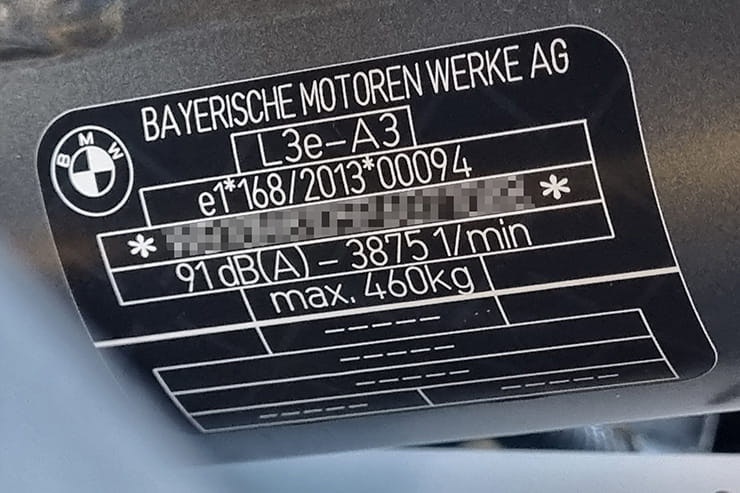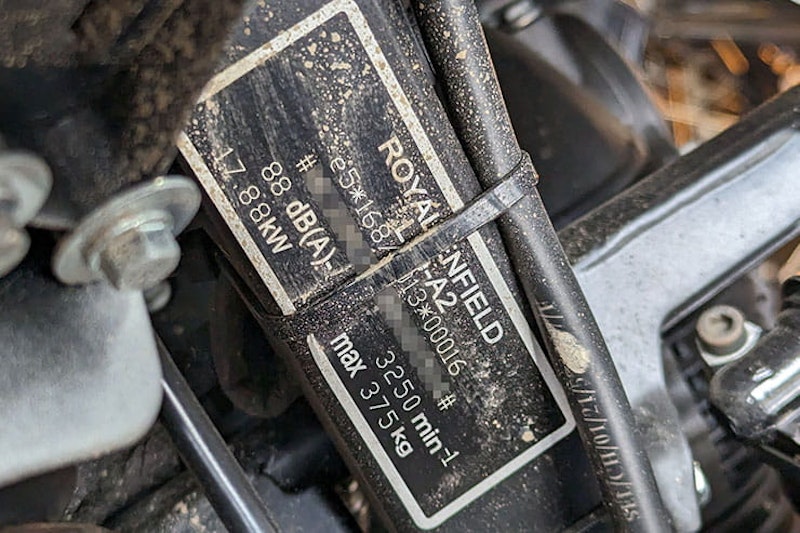How much weight you can carry on your motorcycle
By Dave Yorke
Freelance journalist
19.05.2023
Understanding what the weight here means could save you a fine
If you’re planning a big motorcycle holiday trip this year you’ll probably have spent lots of time researching where you want to go whether you’re staying in the UK or thinking of riding into Europe or even further afield.
If you’re anything like me, you’ve been online looking at the best roads, the best sights and deciding on where you’re going to stay. Will you camp with your motorbike or stay in hotels? Or even a mixture of both?
We all have our own preferences of where we stay and what luggage we take with us but, and there’s always a but, how you load up your bike can have a massive – and maybe costly – effect on your holiday… Did you know that you can be fined by the Police for being overweight on the road?
The weight of your motorcycle – or more importantly the weight it can carry – can be lower than you think, so it’s worth knowing what the maximum weight capacity of your bike is and how to work it out.
The bike’s VIN plate will typically show the gross vehicle weight, or the ‘permitted total weight’. On this Himalayan it’s 375kg
How to find the load capacity of your motorcycle: what weight it can carry
The maximum weight your bike can carry might be stated on the manufacturer’s website, in the owner’s handbook, or some of the better bike reviewers (like Bennetts BikeSocial for instance) will often include it, or you could ask your dealer.
BMW is a good example, with its website clearly showing the maximum load capacity. Others, not so much, and that’s where you might need a little bit of maths.
On the frame of the bike near the headstock you’ll typically find the VIN plate, which will probably have the maximum permitted weight stated on it: that’s the most it could be if the police or DVSA tested it on a weighbridge before you could get fined. If you can’t find that, have a look in the owners’ manual.
Now you need to know how much the bike weighs as standard, which should be easy but can add complications as you need to know if you’re looking at a dry weight (quoted by some manufactures who want to portray their bikes as lighter than the competition, and lapped up by lazy journos/influencers), or a wet weight (also known as kerb weight).
A dry weight can mean no oil, no fuel, no battery, no brake fluid and no coolant… it all adds up, so if it’s a dry weight, as a very rough rule of thumb add 1kg for every litre the tank holds, plus 7kg for the battery and other fluids. Petrol actually weighs 0.79kg/litre, but this rough guide works as it leaves some spare for oil and coolant.
Or of course, you can also take your bike to a weighbridge and get it checked there: we took a BMW R1250RT to one used by the police and DVSA on operations targeting overweight vehicles and found the figures to be pretty accurate. Where BMW quotes 279kg for the R1250RT, it came in at 280kg complete with half a tank of fuel and a packed lunch in the panniers.
Checking the claimed weight of this R1250RT proved BMW to be pretty much on the mark. Maybe unsurprising as the company is also pretty accurate with its rear-wheel power figures
Now you know the maximum permitted weight of the bike (or Gross Vehicle Weight Rating / GVWR), simply subtract the kerb/wet weight and that’s how much you can carry on the bike. Including you and your passenger.
That’s right, you and any pillion you might be riding with need to be included in the amount you can carry; it’s not just luggage. As a quick reference, the average weight of a female in the UK is about 69kg, and for a male that rises to about 84kg, but that is just an average; you might be different to the average, so you’ll need to weigh yourself to get the correct figure and, if you’re anything like me, you’ve probably weighed yourself in your birthday suit, not your bike gear so you’ll have to add all that up to get the true figure.
I had a random look at some of the bike gear we’ve reviewed at Bennetts BikeSocial to see how much it all adds up to…
Helmet: Arai Tour X4 1.7kg
Jacket: Rukka Kingsley 3.2 kg,
Trousers: Rukka Kingsley 2.4kg
Boots: Sidi Adventure 2 2.5kg/pair
So, the total clothing for an adventure rider could come in at 9.9kg. Let’s call it 10kg to account for gloves, base layers, that sort of thing. Times that by two if you’ve got a well kitted-out pillion and you’ve used 20kg of the available weight, just on clothing.
Now add onto that the weight of an average female at 69kg and male at 84kg and you’ve got 173kg.
How much luggage can I safely carry on my motorcycle?
I had a look at three popular adventure bikes for no other reason than the BMW R 1250 GS is constantly among the best sellers in the UK, my wife owns a Honda CB500x, and I’ve previously owned a Royal Enfield Himalayan. Oh, and I threw in a KTM 690 SMCR that I took on tour one year…
The KTM doesn’t have pillion pegs, which is fortunate as that’d mean the average UK male and female could only ride together if they were both naked.
It’s worth noting that the CB500X can only just legally carry the average UK male and female in their kit, and the Himalayan’s homologation leaves it only 1kg better off (two average men is too much for either bike), but this one’s a bit more tricky. Royal Enfield’s UK site doesn’t provide a weight for the bike in its specifications download. The Indian website, however, states that it’s 199kg. As Royal Enfield’s global tactic is to make one bike for all markets (“The huge advantage we have is the economy of scale that allows us to offer the same product to different demographics in different markets”), it seems fair to assume that this is the weight in all territories. Note that the Himalayan owner’s manual, downloadable here states a kerb weight of 182kg, though this was printed in 2016, and described a GVRW of 365kg for a max payload of 183kg.
On my tour with the 690 I played it safe with only a small bag that I just managed to cram five days’ worth of kit in. It was a squeeze and required some, err, imaginative clothing choices. Remember the 300kg had to include me on the top of the 144kg bike.
Think about how much you load a bike up…
Any luggage you carry will probably be in panniers so you’ll definitely need to know the weight of those by themselves, even if they are lightweight aluminium. And don’t forget the pannier mounting system.
Even then, if all your calculations end up under the maximum weight, it’s important not to go over the weight limits that the manufacturer has stated for the panniers. If that top box says max load 10kg, its best not to go over it as it could stress the mounting structure causing it to fail. No matter how sturdy it looks or how much room is left in there.
Remember, we’re only talking average weight here. I’m (ahem) ‘slightly’ over the average so I’m already using allowance that my luggage might have taken up.
If you’ve decided that camping is the only way to go for your two-up trip to the TT or the Alps or wherever then you’ll need a tent, chairs, cooker and whatever else required to turn a field into a home, and it all weighs extra kilos. You’ll need to weigh that lot as well before you set off from home.
Can I get fined if my bike’s overweight
Both the police and the DVSA (Driving and Vehicle Standards Agency) can fine you if you bike’s found to be overweight while riding on the road. Although they’re usually on the lookout for commercial vehicles, the Government website says the authorities can deal with any vehicle on the road and issue fixed penalties as appropriate.
Realistically though, it is very unlikely that your motorcycle would ever get pulled onto a weighbridge, and I should say that in all my years as a police officer, I never weighed a motorcyclist and their bike.
How much is the fine for an overweight motorcycle?
Overweight offences are dealt with by way of a graduated fixed penalty system, so being only between 0-9.99% overweight means a fixed penalty of £100. It’s a non-endorsable offence so that means no penalty points on your licence, and examiners can give a leeway of 5% before issuing a fine.
Do you really need all that kit?
Have a good look at the kit you’re wearing and taking, and try to imagine when and how often you might use it; there’s no point in taking something that you might only use once. Have a look at your clothing as you probably don’t need clothing for 14 days – plenty of campsites have laundry facilities and it only takes an hour or so to clean stuff while you wait for the BBQ to do its thing.
Will additional weight affect my motorcycle’s handling?
It’s best to read the owner’s manual properly and have a good idea of how to set your bike up for any extra weight that you’ll be carrying with you.
A heavily laden bike will be unpredictable on the wrong suspension setting, and will tire you out on a long day’s riding: adjusting the preload can make a big difference.
If you’re unsure how to set your bike up then check out this article, or a quick visit to a suspension specialist will provide you with all the answers you need and shouldn’t cost too much. I had my BMW S1000R set up by a specialist for £50 and it felt better for it.

